
Incarceration in the United States is one of the main forms of punishment and rehabilitation for the commission of felony and other offenses. The United States has the largest prison population in the world, and the highest per-capita incarceration rate. In 2016 in the US, there were 655 people incarcerated per 100,000 population. This is the US incarceration rate for adults or people tried as adults. In 2018 2.2 million Americans have been incarcerated, which means for every 100,000 there are 655 that are currently inmates. This costs the United States government $80 billion dollars a year.

Recidivism is the act of a person repeating an undesirable behavior after they have either experienced negative consequences of that behavior, or have been trained to extinguish that behavior. It is also used to refer to the percentage of former prisoners who are rearrested for a similar offense.
Prison rape commonly refers to the rape of inmates in prison by other inmates or prison staff. In 2001, Human Rights Watch estimated that at least 140,000 inmates had been raped while incarcerated in the United States. A United States Department of Justice report, Sexual Victimization in Prisons and Jails Reported by Inmates, states that "In 2011–12, an estimated 4.0% of state and federal prison inmates and 3.2% of jail inmates reported experiencing one or more incidents of sexual victimization by another inmate or facility staff in the past 12 months or since admission to the facility, if less than 12 months." However, advocates dispute the accuracy of the numbers, saying they seem to under-report the real numbers of sexual assaults in prison, especially among juveniles.
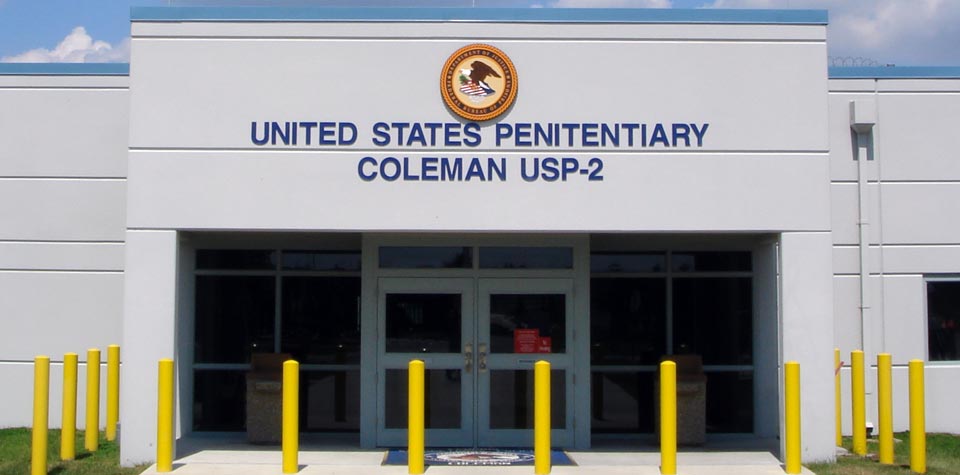
The United States Penitentiary, Coleman I and II are high-security United States federal prisons for male inmates in Florida. It is part of the Coleman Federal Correctional Complex and is operated by the Federal Bureau of Prisons, a division of the United States Department of Justice. USP Coleman 1 was opened in 2001 and in 2004 Clark Construction completed a major 555,000 square-foot additional component for USP Coleman II.

WriteAPrisoner.com is an online Florida-based business whose stated goal is to reduce recidivism through a variety of methods that include positive correspondence with pen-pals on the outside, educational opportunities, job placement avenues, resource guides, scholarships for children impacted by crime, and advocacy. The site began primarily as a place to post pen-pal profiles and requests for legal assistance for inmates and has evolved to take a more comprehensive approach to addressing the challenges in the life of an inmate.
A prison nursery is a section of a prison that houses incarcerated mothers and their children. Prison nurseries are not common in correctional facilities in the United States, although prior to the 1950s many states had them and they are widespread throughout the rest of the world.
The Indiana Women's Prison was established in 1873 as the first adult female correctional facility in the country. The original location of the prison was one mile (1.6 km) east of downtown Indianapolis. It has since moved to 2596 Girls School Road, former location of the Indianapolis Juvenile Correctional Facility. As of 2005 it had an average daily population of 420 inmates, most of whom are members of special-needs populations, such as geriatric, mentally ill, pregnant, and juveniles sentenced as adults. By the end of 2015 the population increased to 599 inmates. Security levels range from medium to maximum. The prison holds Indiana's only death row for women; however, it currently has no death row inmates. The one woman under an Indiana death sentence, Debra Denise Brown, was being held in Ohio. before she was executed in 2002
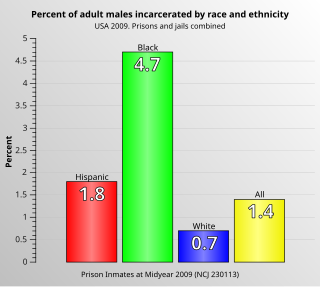
Race in the United States criminal justice system refers to the unique experiences and disparities in the United States in regard to the policing and prosecuting of various races. There have been different outcomes for different racial groups in convicting and sentencing felons in the United States criminal justice system. Experts and analysts have debated the relative importance of different factors that have led to these disparities. Minority defendants are charged with crimes requiring a mandatory minimum prison sentence more often, in both relative and absolute terms, leading to large racial disparities in correctional facilities.
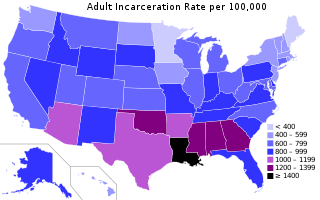
In September 2013, the incarceration rate of the United States of America was the highest in the world, at 716 per 100,000 of the national population. While the United States represents about 4.4 percent of the world's population, it houses around 22 percent of the world's prisoners. Corrections cost around $74 billion in 2007 according to the U.S. Bureau of Justice Statistics.

A prison, also known as a correctional facility, jail, gaol, penitentiary, detention center, remand center, or internment facility is a facility in which inmates are forcibly confined and denied a variety of freedoms under the authority of the state. Prisons are most commonly used within a criminal justice system: people charged with crimes may be imprisoned until their trial; those pleading or being found guilty of crimes at trial may be sentenced to a specified period of imprisonment.

The United States Penitentiary, Pollock is a high-security United States federal prison for male inmates in Louisiana. It is part of the Pollock Federal Correctional Complex and operated by the Federal Bureau of Prisons, a division of the United States Department of Justice. The facility also has an adjacent satellite prison camp for minimum-security male offenders.
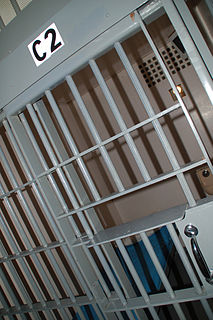
Lesbian, gay, bisexual, and transgender (LGBT) prisoners often face additional challenges compared to non-LGBT prisoners. According to Just Detention International, LGBT inmates are "among the most vulnerable in the prison population". 67% of LGBT prisoners in California report being assaulted while in prison. The vulnerability of LGBT prisoners has led some prisons to separate them from other prisoners, while in others they are housed with the general population.
Sister Elaine Roulet is a Roman Catholic sister who created programs that connect incarcerated mothers and their children. She was instrumental in the prison reform movement and established the precedent of connecting imprisoned mothers with their babies that many United States prisons now use as a model.

The alternatives to imprisonment are types of punishment or treatment other than time in prison that can be given to a person who is convicted of committing a crime. Some of these are also known as alternative sanctions. Alternatives can take the form of fines, restorative justice, transformative justice or no punishment at all. Capital punishment and corporal punishment are also alternatives to imprisonment, but are not promoted by modern prison reform movements.
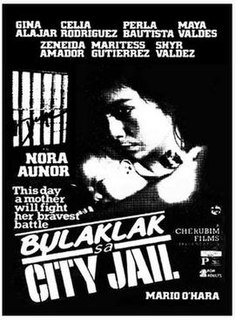
Bulaklak sa City Jail is a 1984 drama film that depicts the situation of women in the city jail, the last item in a series of outstanding outputs by the local movie industry in 1984. Among other things, three distinctions will secure it as a last a footnote in the history of contemporary Philippine cinema: the people involved in its production marks an auspicious debut for the Cherubim outfit, it showcases Nora Aunor's best performance for her comeback year, and it signals the emergence of Mario O’Hara as a director whose command of craft has caught up with his conscience – an expectation which seemed to have been forgotten in the wake of similar successes by relatively more recent filmmakers. The story follows the searing odyssey of Angela, a victim of a miscarriage of justice, from her incarceration in the women’s section of an urban prison, through her escape and delivery of her love child in a city zoo, to her recapture and eventual legal triumph in obtaining custody of her baby.

This article discusses the incarceration of women in prisons and jails within the United States. According to a November 2017 report by the World Prison Brief, around 212,000 of the 714,000 female prisoners worldwide are incarcerated in the United States. That report states: "The highest female prison population rates are in the U.S.A., Thailand (60.7), El Salvador (58.4), Turkmenistan, Seychelles (34.8), Russian Federation (33.5), French Guiana (32.4), Macau-China (31.3), Rwanda (29.6), Greenland (28.5) and American Samoa (27.3)."
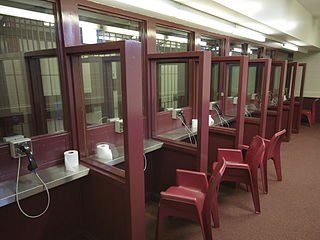
Incarcerated individuals' relationships are the familial and romantic relations of individuals in prisons or jails. Although the population of incarcerated men and women continues to increase, there is little research on the effects of incarceration on inmates' social worlds. However, it has been demonstrated that inmate's relationships play a seminal role in their well-being both during and after incarceration, making such research important in improving their overall health, and lowering rates of recidivism.
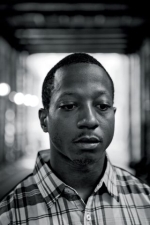
Kalief Browder was an African American man from The Bronx, New York. In 2010, at the age of 16, Browder was accused of the theft of a backpack and its contents, which included a camera, $700, a credit card, and an iPod Touch. Awaiting his trial, Browder was jailed on Rikers Island for three years, nearly two of which were spent in solitary confinement. He was released when the prosecutor's case was found to be lacking evidence against Browder and the case's main witness had left the United States. Two years after his release from prison, Browder died after hanging himself from an air conditioning unit outside his mother's home. Browder's supporters say his suicide was the result of mental and physical abuse sustained in prison. His case has been cited from activists campaigning for the reform of the New York City criminal justice system and has attracted widespread attention in the years following his death. In 2017, Jay-Z and Harvey Weinstein released a television documentary series titled Time: The Kalief Browder Story.

Winefreda Amit Geonzon was a Filipina lawyer and social justice activist. She was the founder and executive director of the Free Legal Assistance Volunteers Association, a service organization that provides free legal assistance for poor prisoners. For her efforts, she received the Right Livelihood Award in 1984.













